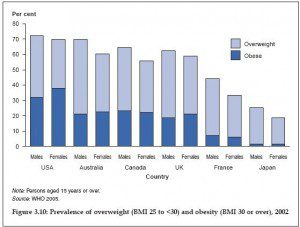 Obesity rates have been skyrocketing over the last three decades, and the epidemic shows no sign of slowing. While populations the world over have seen rising obesity rates, the West has been especially susceptible to the dangerously unhealthy rise in average weight, with all the health complications that come with it.
Obesity rates have been skyrocketing over the last three decades, and the epidemic shows no sign of slowing. While populations the world over have seen rising obesity rates, the West has been especially susceptible to the dangerously unhealthy rise in average weight, with all the health complications that come with it.
Three new studies being published in the Lancet, a British medical journal, state that worldwide obesity rates have doubled in the last 30 years. Despite the alarming increase in obesity, however, cholesterol and blood pressure levels have fallen. Study researchers have stated that they are worried about how much worse the world’s obesity problems could get.
One of the studies found that Pacific Islanders, such as the American Samoa, are the heaviest. Among developed nations, Americans are the heaviest while the Japanese are the thinnest.
“Being obese is no longer just a Western problem,” said Majid Ezzati, professor of public health at Imperial College London. Ezzati was an author on one of the studies being published in the Lancet. The obesity epidemic has made appearances nearly everywhere in the world, and it’s affecting health and lifespans wherever it crops up.
A series of articles in the Lancet states that the increases in obesity in almost all countries around the world seem to be motivated primarily by changes in the global food system. More food is being consumed than ever before, and it is also more processed, affordable, and effectively marketed.
In 1980, only about 5% of men and 8% of women around the world were classified as obese. As of 2008, that number had jumped to almost 10% for men and 14% for women. The frightening numbers translate to 205 million obese men and 297 million obese women around the world. Additionally, 1.5 billion adults around the world are considered “overweight.”
The richer nations of the world are more effective at lowering cholesterol and blood pressure levels. However, according to the researchers, people are becoming heavier almost everywhere in the world, except for a few areas including South Asia and central Africa.
The obesity epidemic has been found to be related to the increasing levels of caloric energy available to people throughout the years. While the amount of energy available to people in different areas of the world varies widely, it has increased drastically in nearly all areas of the world over the last 50 years.
From 1971 to 2004, women in the U.S. consumed an average of 335 more calories per day. In the same time period, men consumed 168 more calories per day, with much of the increases in caloric consumption being made up by carbohydrates such as processed and refined sugars found in soft drinks.
Obesity increases the risk of a host of diseases, including Type 2 diabetes, heart disease, osteoarthritis, and some types of cancer. Additional physical complications such as sleep apnea can also be caused by obesity. It is the leading cause of preventable death around the world and it is seen as one of the most pressing health problems of the 21st century. It has been found to reduce life expectancy and, according to a 2005 article published in the Lancet, it is the sixth most-important risk factor in contributing to the overall burden of disease around the world. Obesity is a public health problem because of its prevalence and its effect on the overall health of the public as well as the additional health care costs associated with it.